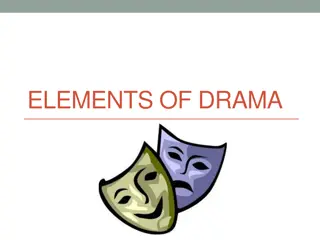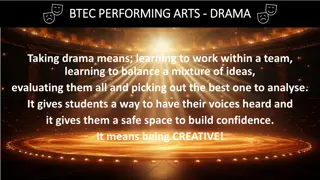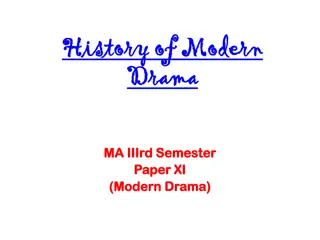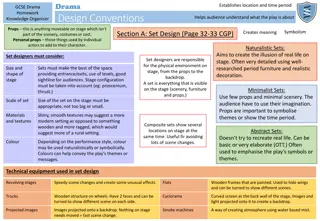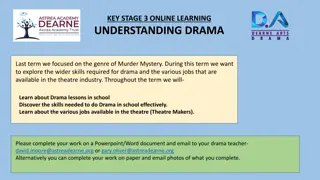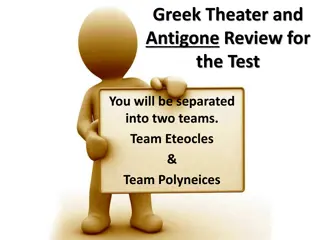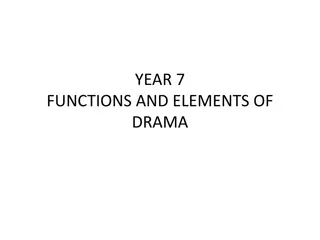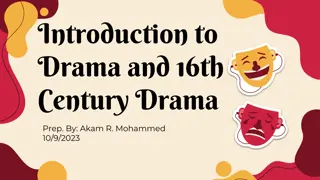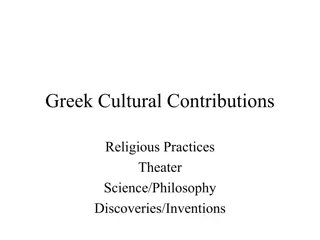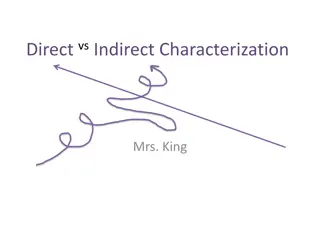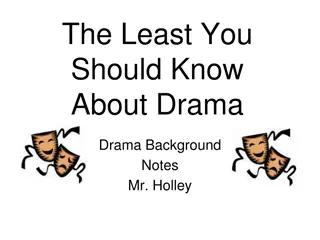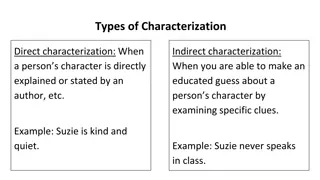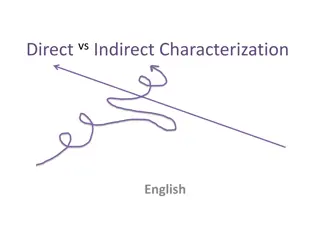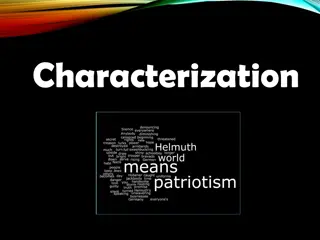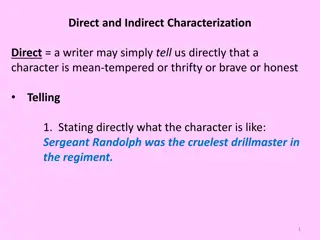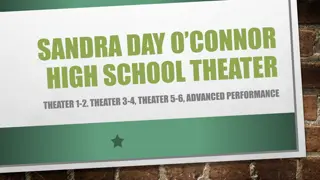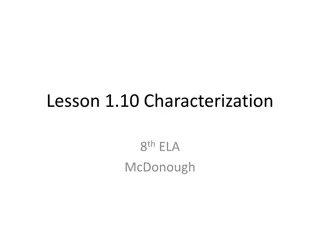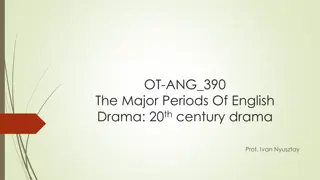Theater Conventions and Characterization in Drama
Theater conventions such as prologues, epilogues, dialogues, monologues, and dramatic structure like exposition, rising action, climax, falling action, and resolution are explored in drama. Additionally, the importance of character creation through techniques like backstories, flashbacks, and flashforwards is emphasized for a believable and engaging performance.
Download Presentation

Please find below an Image/Link to download the presentation.
The content on the website is provided AS IS for your information and personal use only. It may not be sold, licensed, or shared on other websites without obtaining consent from the author.If you encounter any issues during the download, it is possible that the publisher has removed the file from their server.
You are allowed to download the files provided on this website for personal or commercial use, subject to the condition that they are used lawfully. All files are the property of their respective owners.
The content on the website is provided AS IS for your information and personal use only. It may not be sold, licensed, or shared on other websites without obtaining consent from the author.
E N D
Presentation Transcript
DRAMA Understanding Drama Some performances may end with an epilogue. Epilogues can be used to Year 9 + 10 Knowledge Organiser Autumn 2 Section B: Theatre Conventions Section A: Dramatic Structure Stage Directions: Some might start with a prologue. This is a short introduction to the story which gives the audience some background details. Act Two: RISING ACTION AND CLIMAX Develops characters and builds up to a climax. Instructions written in a script to explain how a play should be performed. summarise or comment on the ending. The way characters say their lines Act Three: FALLING ACTION AND RESOLUTION Conflict is resolved and settled, loose ends tied up. Play ends. The scenery, props and furniture The characters movements Act One: EXPOSITION Introduction of main characters and hints at a conflict they may face. Some plays have very limited stage directions. This gives the freedom to adapt the play to suit their own ideas. Narrators: Some plays use narrators to give the audience extra information. Also a common way of breaking the fourth wall. If someone comments on the action without taking part, they are omniscient and are able to tell the audience what the characters are thinking. BLOOD BROTHERS Always consider where a narrator is placed on stage Section B cont Theatre Conventions DUOLOGUE: when 2 characters have a conversation together. Dialogue: This is the term given to lines that are spoken between characters. MONOLOGUE: a character makes a speech to another character or the audience. Some moments are so important they need to be emphasised. MARKING THE MOMENT SOLILOQUY: a character speaks to themselves to express their feelings. Gets the audience emotionally involved, as the character is expressing their inner most thoughts and feelings. FREEZE FRAME Action freezes, a character steps out to talk to the audience ASIDE: when a character makes a comment to another character or to the audience and the other characters onstage do not hear it. Can be done for comic effect. SLOW MOTION The physical action slows down for emphasis Dramatic Irony Cross-Cutting TABLEAU Frozen picture Dramatic irony is when the audience knows something the other characters don t. When 2 or more scenes that take place in different times or places Are performed on stage at the same time. The audience might witness an important event that some of the characters aren t on stage to see. A character could reveal hidden thoughts and feelings to the audience in an aside or soliloquy. Disguises allow the characters to hide their true identity but the audience can see through them. 1
DRAMA Understanding Drama Year 9+10 Knowledge Organiser Autumn 2 Section B cont Theatre Conventions Section C Characterisation . Page 20-23 CGP Flashback and Flashforward:These conventions play around with time. Constantin Stanislavski felt that actors should understand their character s backstory, as it gives them motivation and makes for a more convincing performance. (Naturalism) FLASHBACK: Scenes that go back in time Create a non-linear plot without causing the audience too much confusion. FLASHFORWARD: How to create a backstory: Decide what age your character is Scenes that go forward in time to show the audience events that will happen in the future. Provides audience with clues about what will happen later and creates dramatic irony. 1. 2. Decide where your play is set, as the social and historical context of the play will determine how your character behaves. 3. Are there any significant events that have happened in your character s past? Both are used to: Key steps to character creation: Backstory Social/historical Context this affects how the character will behave and react to situations. Role on the wall what you think of yourself as the character and what others think of the character. Hot seating audience can ask the character questions to get more information from them about their history etc. Reveal information the audience didn t know before, or show a new side to a character. Character Creation: Always ask yourself: Is my character believable? Am I using vocal and physical skills that show the appropriate age and social class of the character? Are my actions and reactions appropriate in the historical context of the play? 2
DRAMA Understanding Drama Year 9+10 Knowledge Organiser Autumn 2 Section C cont... Characterisation Rehearsal Techniques for effective characterisation Method acting: when a performer fully immerses themselves in their role and aims to become their character both on and off stage. Hot-seating:an actor in the hot seat is asked questions by the rest of the cast and they must answer in role as their character. This can help the actor to imagine how their character would react in different situations. Status games: it s important for a performer to understand their relationships with other characters. Arranging the cast into a tableau, using levels and space to indicate high and low status characters and their relationships with each other. Can also show how different characters might treat each other. Defend a character: this involves being a character's lawyer and defending them against some of the things they have done justifying the character s actions. Conscience alley: group splits in to 2 lines. A character walks between the lines and each member (in character or not) gives them advice about a decision they have to make. This helps the group understand this character better. Section D Vocal Skills. Pages 28-30 CGP A way of pronouncing a language (country, area or social class) Accent Performers need to express themselves. Vocal performance is the way a performer speaks their lines. Voice can tell the audience so much about a character's emotional state, status, background and personality. Vocal performance adds meaning to a character's words (sarcasm, persuasion, insincerity.) The way characters speak to each other tells the audience a lot about their relationship with one another. Vocal performance can also show how a character changes throughout a performance. Volume How loud or quietly someone speaks Pitch How high or low someone speaks Tone How something is said sarcastic tone, happy tone, sad tone Timing Use of pause or silence. The rhythm of the way you speak Pace How fast or slow someone speaks Intonation The rise and fall of the voice How something is said for dramatic effect (pause, emphasise words) Phrasing Emotional range Happy, sad, scared, shy, nervous (linked with tone) Working with other actors (linked with timing) action - reaction Delivery of lines 3
DRAMA Understanding Drama Year 9+10 Knowledge Organiser Autumn 2 Section F plot and subplots. Linear and non-linear Section E Physical Skills. Pages 24-27 CGP How someone stands and/or sits (slouched, upright) Posture Eye contact Location on stage Reacting to others Doesn t take audience attention from main plot. Reveal more about the characters How someone uses their hands and arms when they are speaking Gesture Body language: Body language is a type of non- verbal communication. A performer can use movements, facial expression and posture to communicate how a character is feeling. Facial expression How the face is used to communicate feeling. (EG open mouthed, scrunched eyes, pouted lips.) SUBPLOT Adds to the main plot. Adds Different tone than the rest of the play complexity to the story How someone moves around the stage space. This also includes physical theatre movement (dance, unison movement.) Movement Movement and stillness can be very effective. Make a play more varied focusing on different characters or issues than the main plot. Gait How someone walks (stride, leap, shuffle.) CONFLICT: Section F plot and subplots. Linear and non-linear A LINEAR plot is chronological and easier to follow Is a key element of a plot. It can be: A Disagreement A Problem that needs solved An obstacle that needs to be overcome. How the conflict is resolved depends on the genre of the play: Comedy = happy ending Tragedy = tragic ending (death, pain, suffering) CLIFFHANGER audience must guess what will happen A NON-LINEAR plot jumps backwards and forwards to different events and times. PLOT: The series of events that take play in a play. ALL plots need a beginning, a middle and an end. CYCLICAL PLOTS begin and end in the same place. Blood Brothers 4


